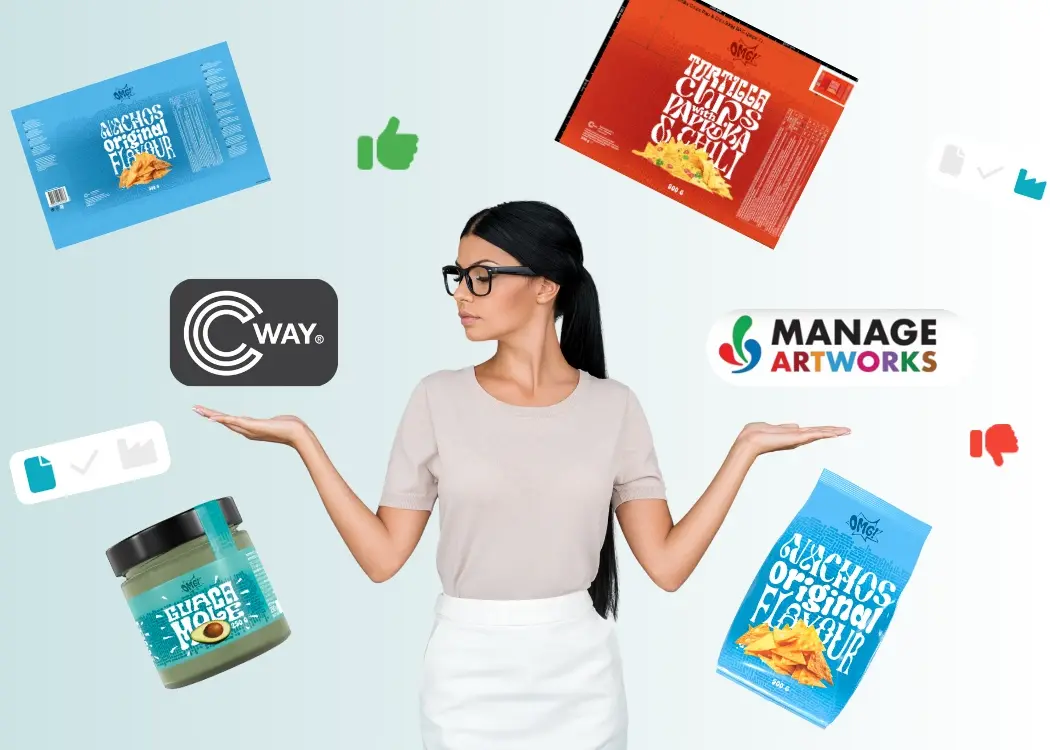ManageArtworks vs Cway: which software suits your packaging needs?
When it comes to managing packaging artwork, businesses in the food, consumer packaged goods (CPG), and pharmaceutical industries face the challenge...
3 min read
 Ekaterina Skalatskaia
:
August 17, 2025 at 12:00 PM
Ekaterina Skalatskaia
:
August 17, 2025 at 12:00 PM

Starting your role as a packaging manager can feel overwhelming. You’re juggling multiple SKUs, approvals, and deadlines, all while trying to keep your team aligned. One of the most critical things you can do in your first weeks is set up a scalable, repeatable artwork workflow that minimizes errors and keeps projects on track.
This guide walks you through what to do in your first 90 days, with actionable steps for each stage. We’ll also show how tools like Cway can help you centralize approvals, track versions, and streamline communication, so you spend less time chasing files and more time building a smooth process.
Goal: Observe, audit, and learn before making changes.
Your workflow touches multiple teams. Start by talking to:
Marketing/Brand – Own the creative brief.
Legal/Compliance – Review content and claims.
Design (in-house or agency) – Create the artwork.
R&D/Product – Provide technical specifications.
QA or Packaging Engineering – Ensure manufacturability.
Printers or Vendors – Receive final files and execute production.
Ask each stakeholder about the biggest frustrations, delays, or errors they encounter. These insights will help you design a workflow people actually want to follow.
Document how artwork projects currently move from idea to print. Key questions:
Who initiates projects?
Where are files stored, and are versions tracked?
How are approvals handled?
What tools are used for communication and feedback?
Most teams rely on a mix of email, shared drives, spreadsheets, and design tools. Without a central system, it’s easy to lose track of versions and approvals.
Pro tip: Import your current projects into Cway. You can visualize every stage, file, and approval in one place, quickly identifying bottlenecks and gaps.
Look at 3–5 recent artwork projects. Note:
How many revisions were needed?
Where did delays occur?
Were any errors caught late?
This will help you spot recurring problems, like missing briefs or unclear ownership. For tips on preventing errors and improving your workflow, explore Cway’s article on 5 packaging artwork approval mistakes.
Turn Artwork Challenges into Efficiency Wins
See how Cway streamlines collaboration and keeps projects on track. Get your free consultation now!
Goal: Build a system that is repeatable and can grow with your team.
A scalable artwork workflow typically includes:
Briefing – Define SKU details, deadlines, claims, and assets.
Design & Development – Create initial drafts and versions.
Internal Review – Feedback from Marketing or Product teams.
Compliance/Legal Review – Verify regulatory requirements.
Artwork Finalization – Apply final tweaks, adjust mechanicals or die-lines.
Printer Handoff – Deliver production-ready files.
Assign clear owners and deadlines for each stage. If everyone is responsible, nothing gets done. Using Cway, all stakeholders receive automatic notifications at each step, ensuring no stage is missed and feedback is collected promptly. This keeps the artwork approval workflow moving efficiently and helps teams stay on track.
Templates reduce confusion and keep everyone aligned:
Creative brief template: Includes SKU, claims, dimensions, regulatory constraints, and assets needed.
Compliance checklist: Industry-specific checks for labeling, barcodes, or warnings.
Reviewer matrix: Defines who approves what, and in which order.
As you map your ideal workflow, notice where current tools fall short:
Scattered files across email, drives, or desktops
No version control or audit trail
Feedback hard to track
Compliance checks late in the process
Cway can centralize briefs, artwork, feedback, and approvals into one platform. This reduces errors, improves visibility, and saves time.
Get Control Over Artwork Approvals
Discover expert strategies to reduce delays and streamline your packaging workflow.
Goal: Start small, validate improvements, and build confidence.
Pick an upcoming project, like a label refresh or a small SKU launch. Introduce one or two workflow changes:
Use your new brief and compliance checklist
Assign clear roles for feedback and approvals
Track versions and comments in Cway
As the project progresses, ask:
Did approvals move faster?
Were there fewer revisions?
Did team members feel the process was clearer?
Share your improvements with the team, but keep adoption optional at first. Gradually:
Introduce templates for other projects
Use Cway analytics to monitor timelines and bottlenecks
Continuously refine your workflow based on real data
A great artwork workflow is never truly “finished.” After your first 90 days, focus on continuous improvement and optimization:
Automate repetitive tasks to save time and reduce errors.
Improve brief clarity to minimize back-and-forth between teams.
Maintain a scalable system that grows with your team and SKUs.
Your biggest value as a packaging manager is designing a workflow where the right thing is the easiest thing to do. Using templates, clear workflow stages, and centralized tools reduces mistakes and keeps everyone aligned.
Tools like Cway make it simple to track performance metrics, monitor workflow efficiency, and support team adoption—so you can focus on strategy and quality, rather than firefighting day-to-day issues.
By continuously iterating and leveraging tools like Cway, your artwork workflow becomes not just functional, but scalable, repeatable, and future-proof.
The first 90 days are about learning, mapping, and building a system, not just completing projects.
Your biggest value as a packaging manager is designing a workflow where the right thing is the easiest thing to do.
Templates, clear stages, and centralized tools reduce errors and confusion.
Cway makes workflow setup and team adoption easier, letting you focus on strategy and quality instead of firefighting.

When it comes to managing packaging artwork, businesses in the food, consumer packaged goods (CPG), and pharmaceutical industries face the challenge...

Endless email chains, delayed approvals, and costly reworks — if this sounds familiar, it’s time to consider automated artwork management. This...

If you're part of a team that creates packaging—whether it’s for yoghurt tubs, medicine boxes, or shampoo bottles—you know how tricky it can be to...